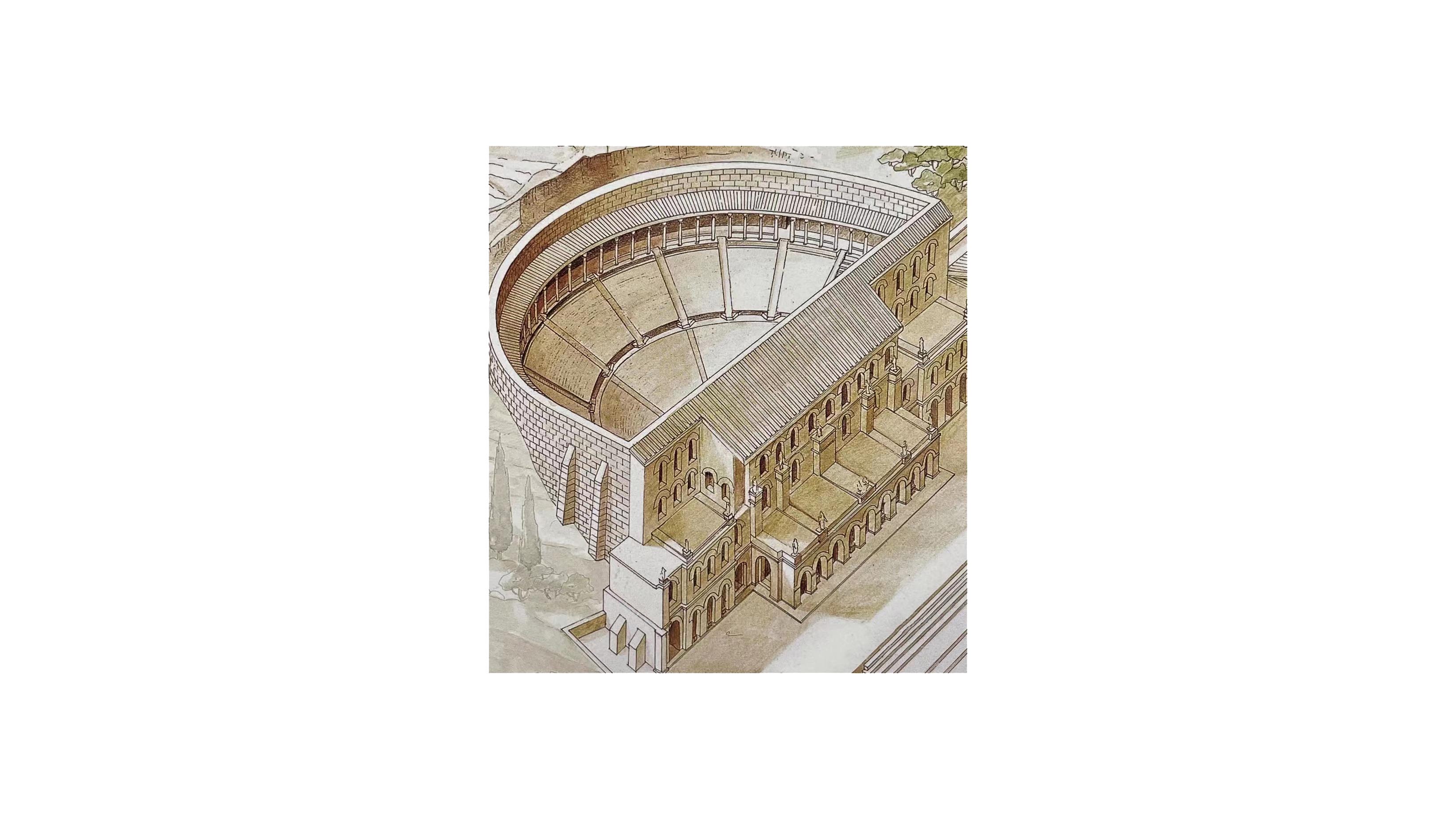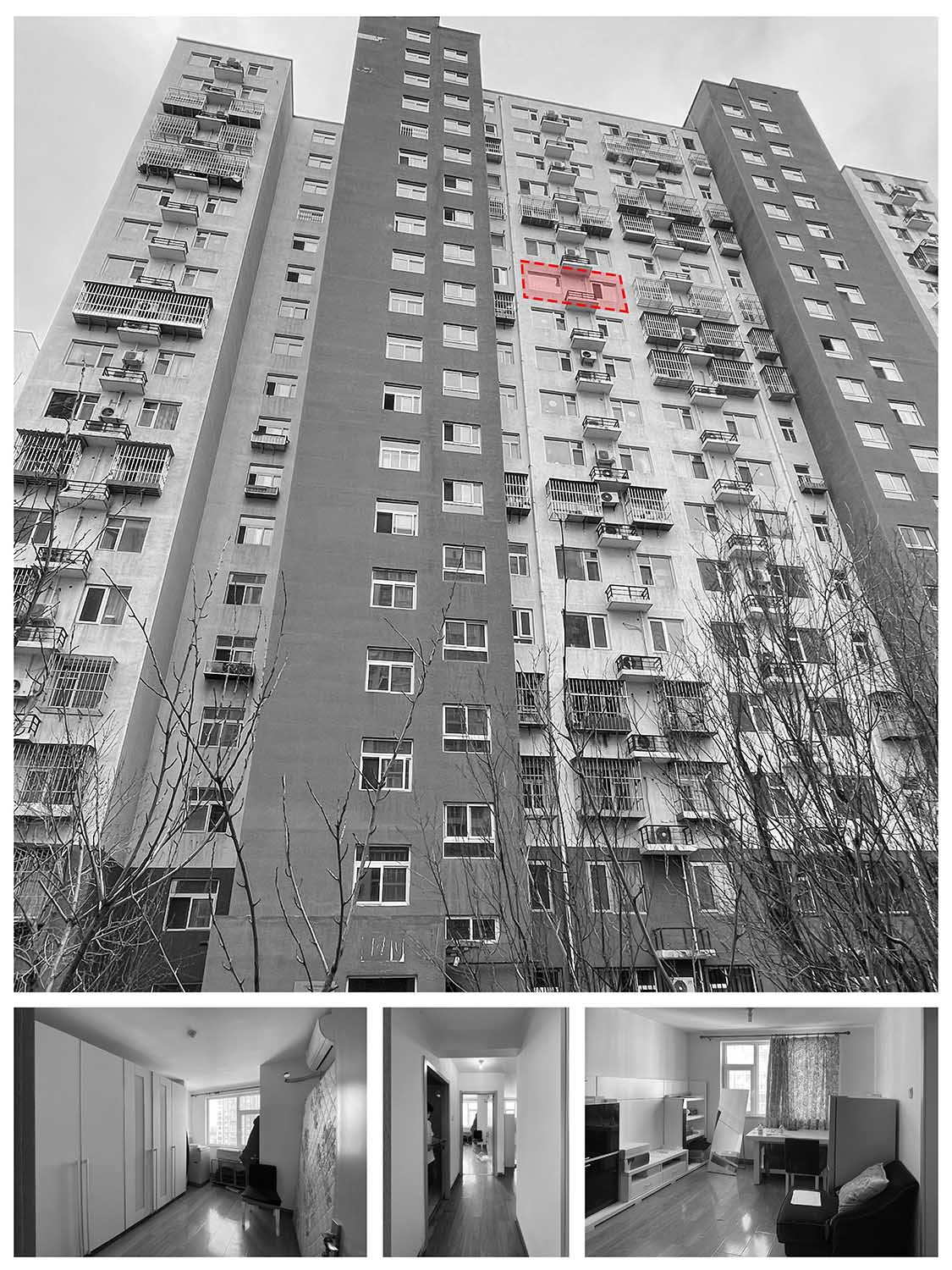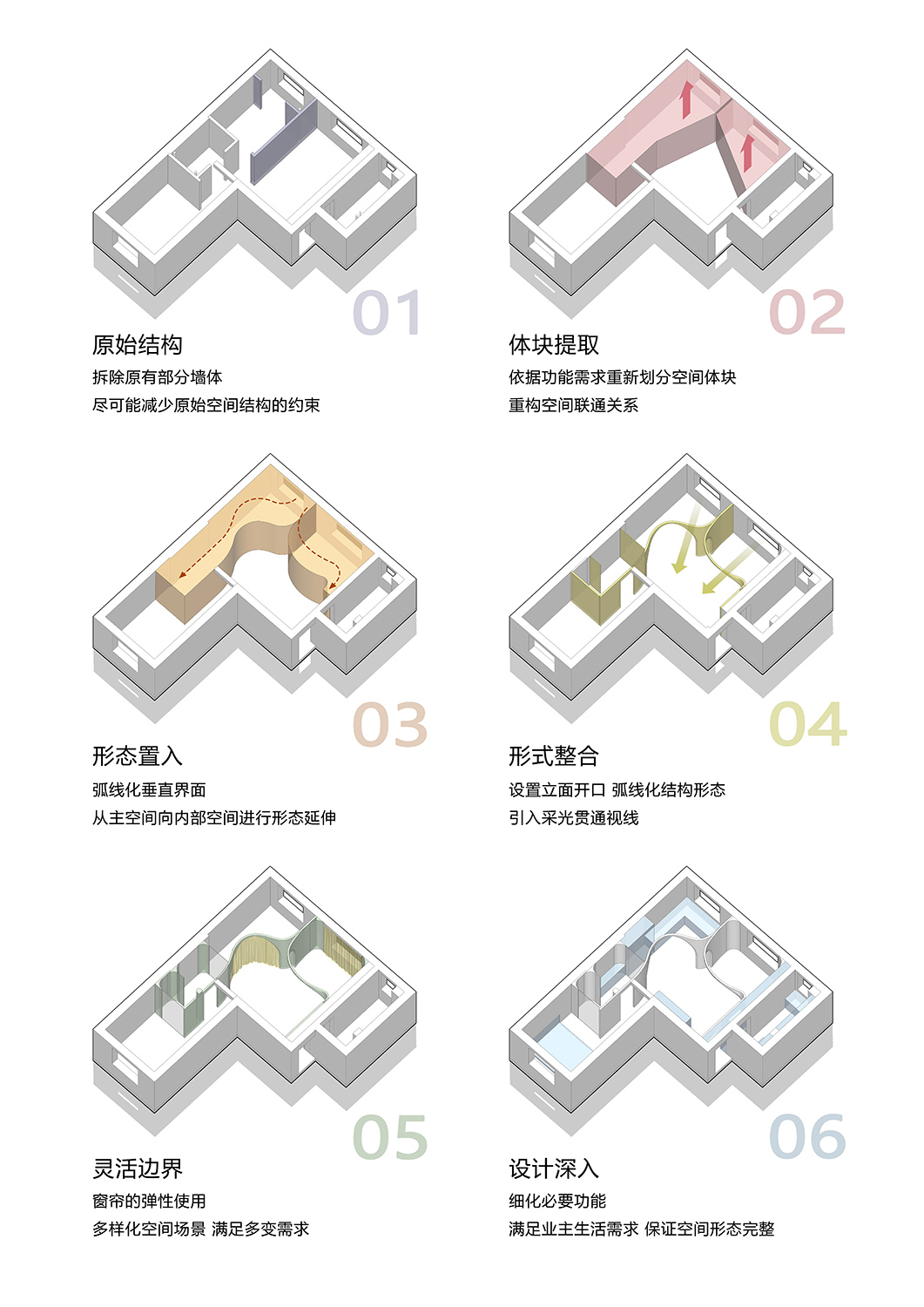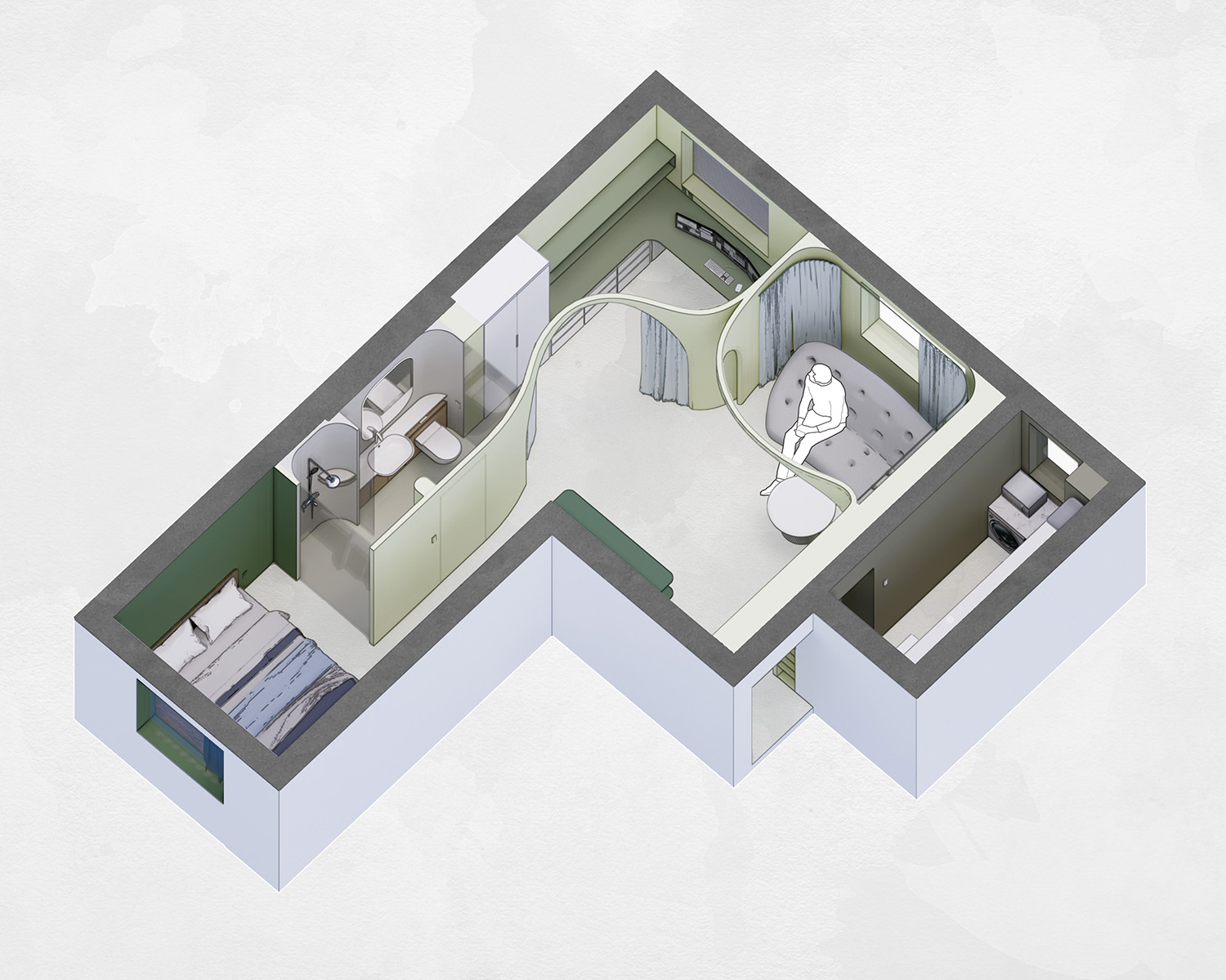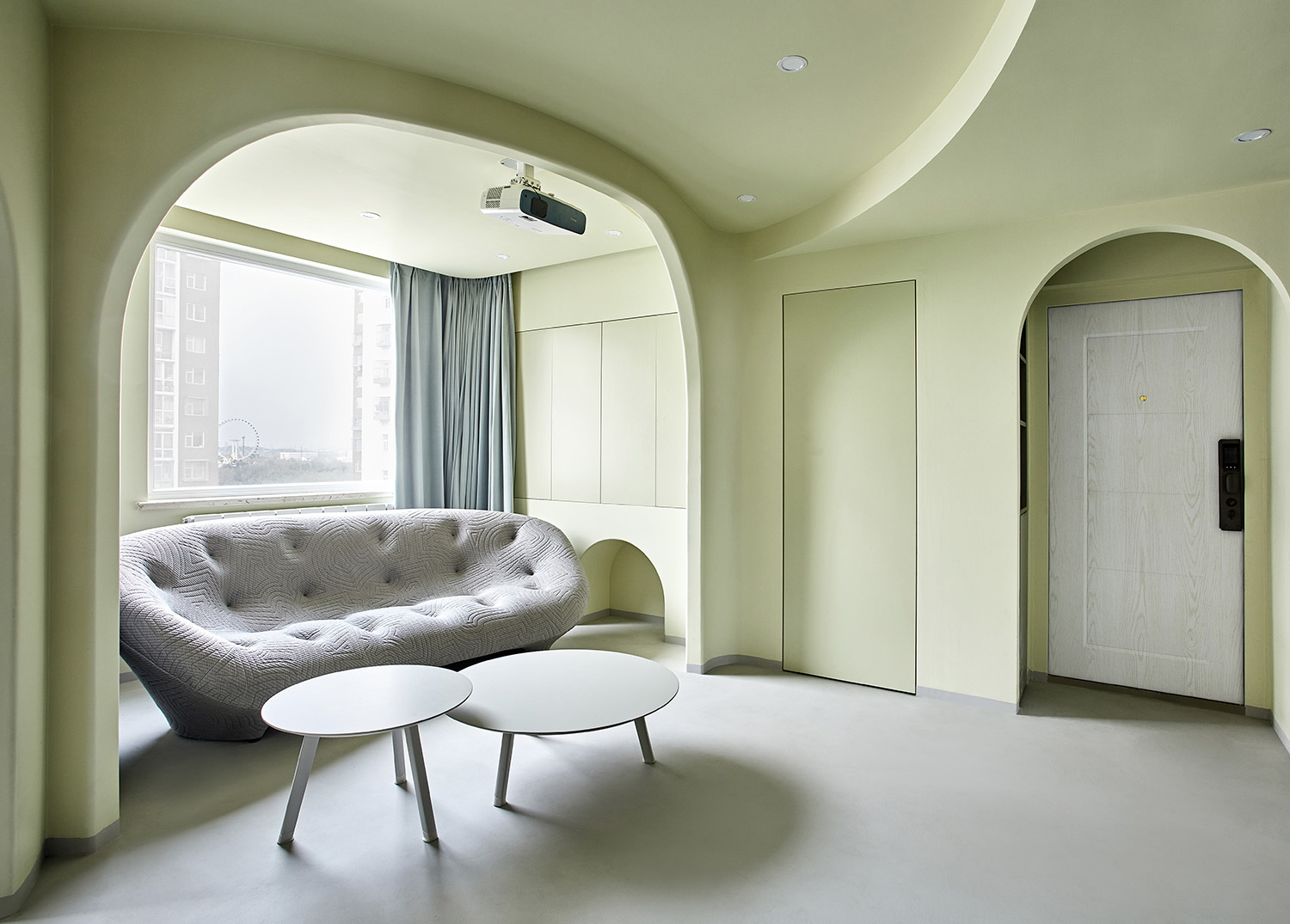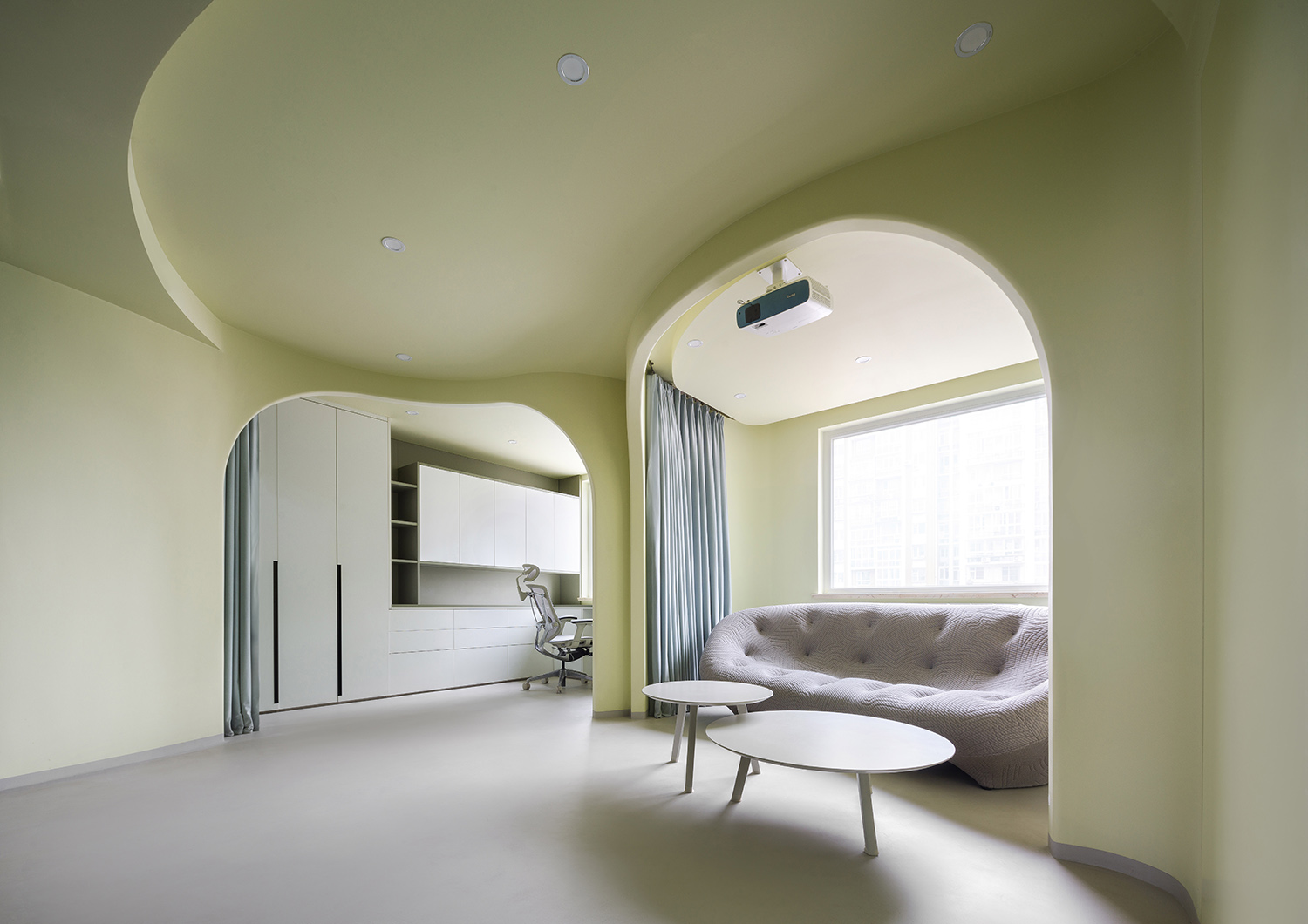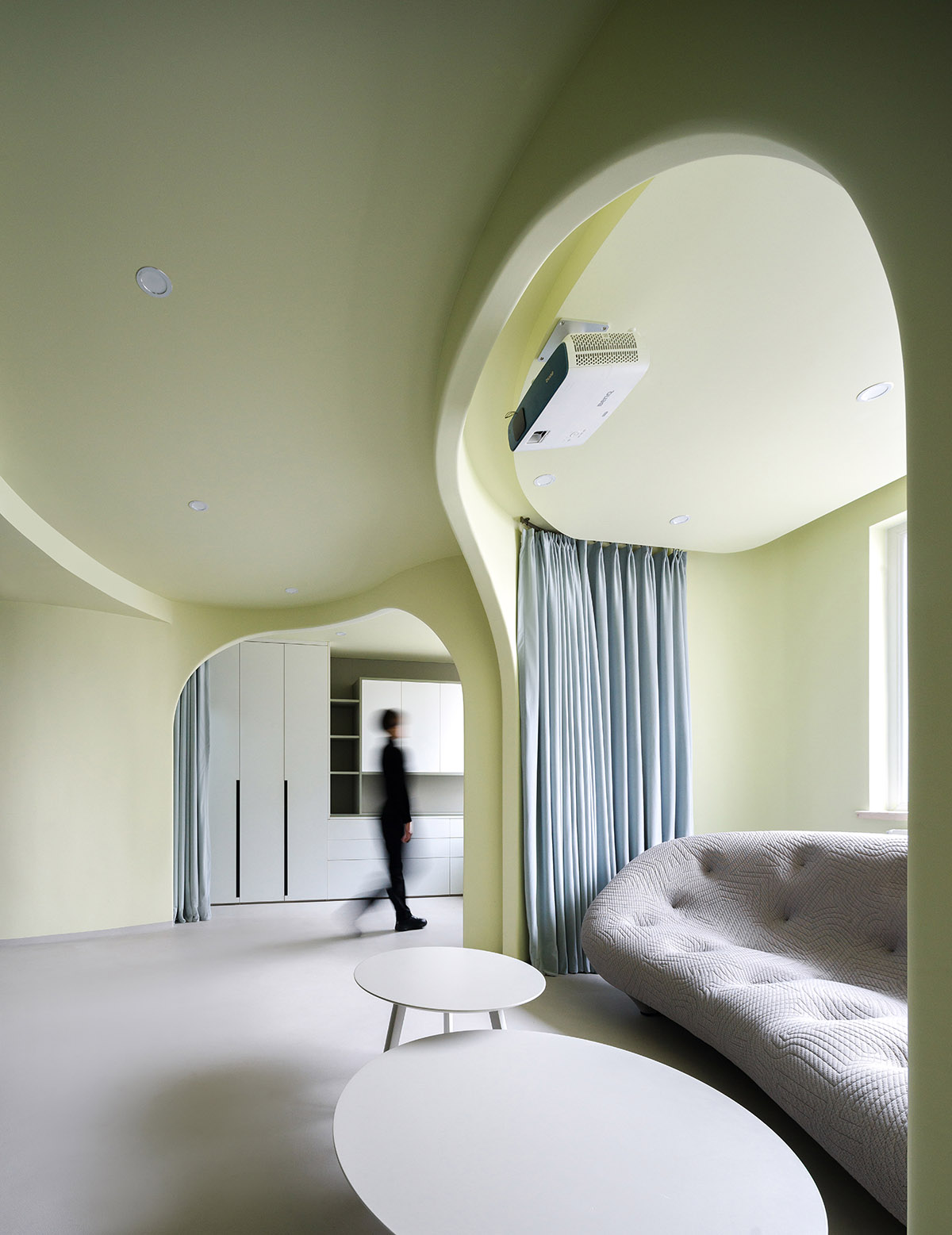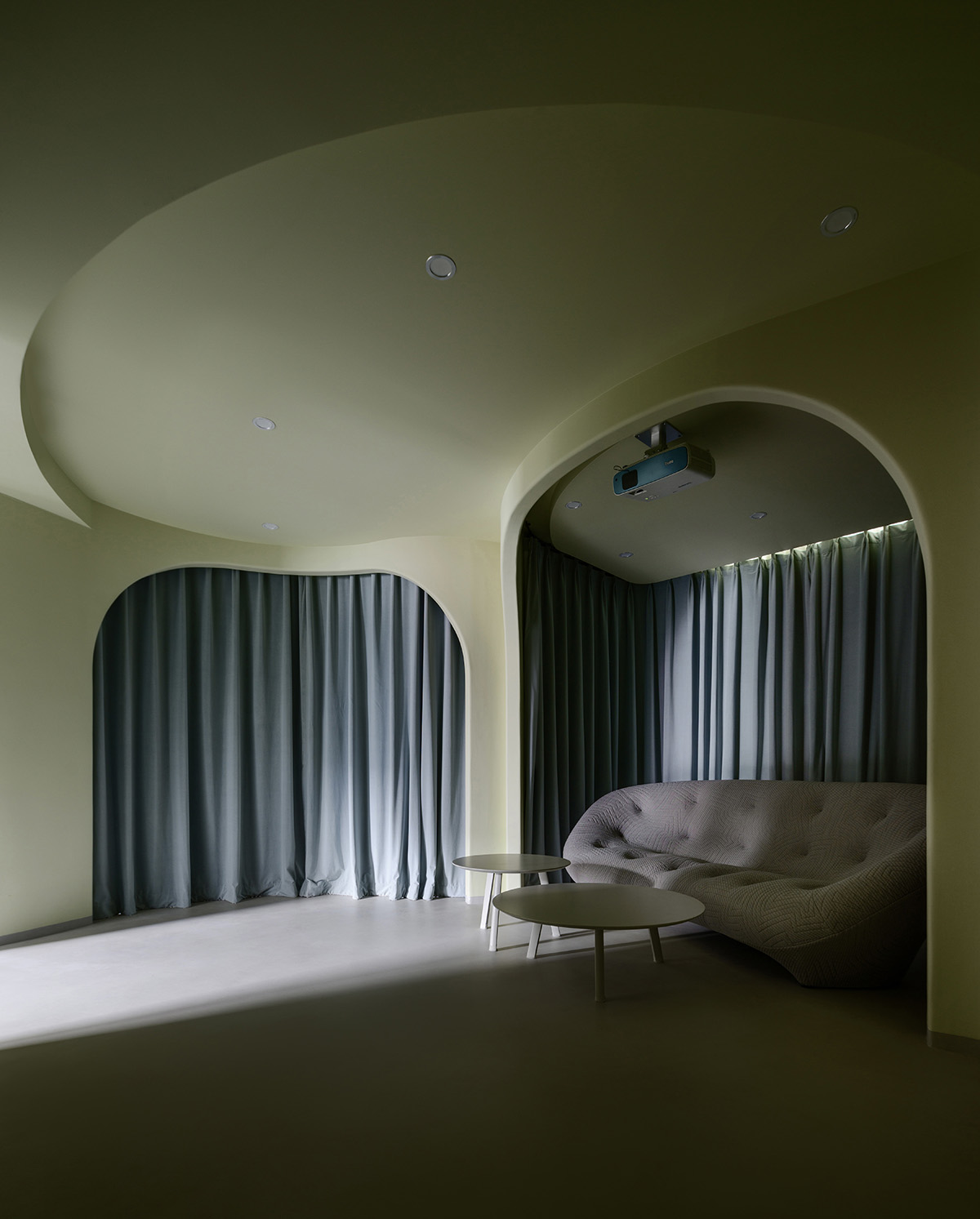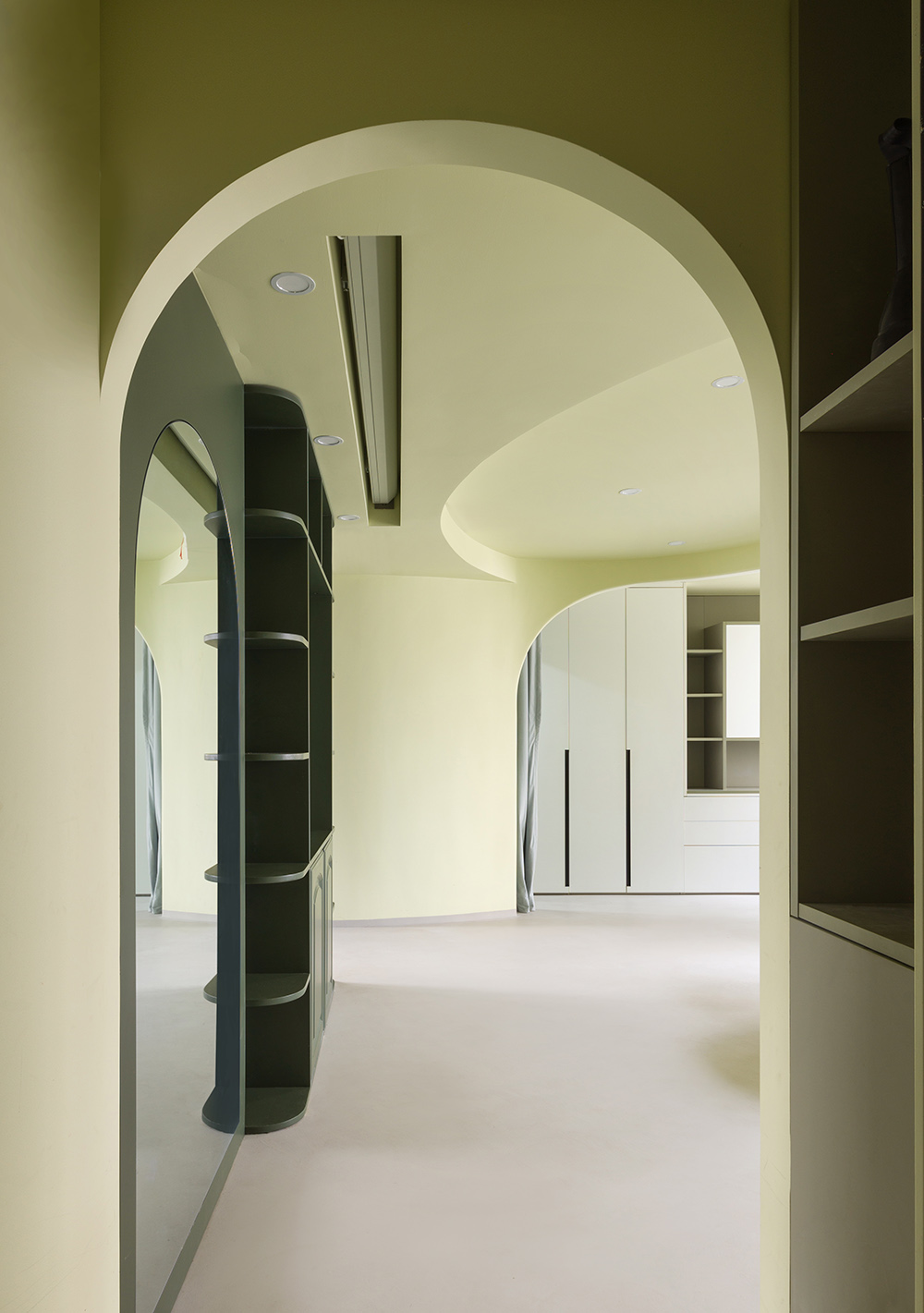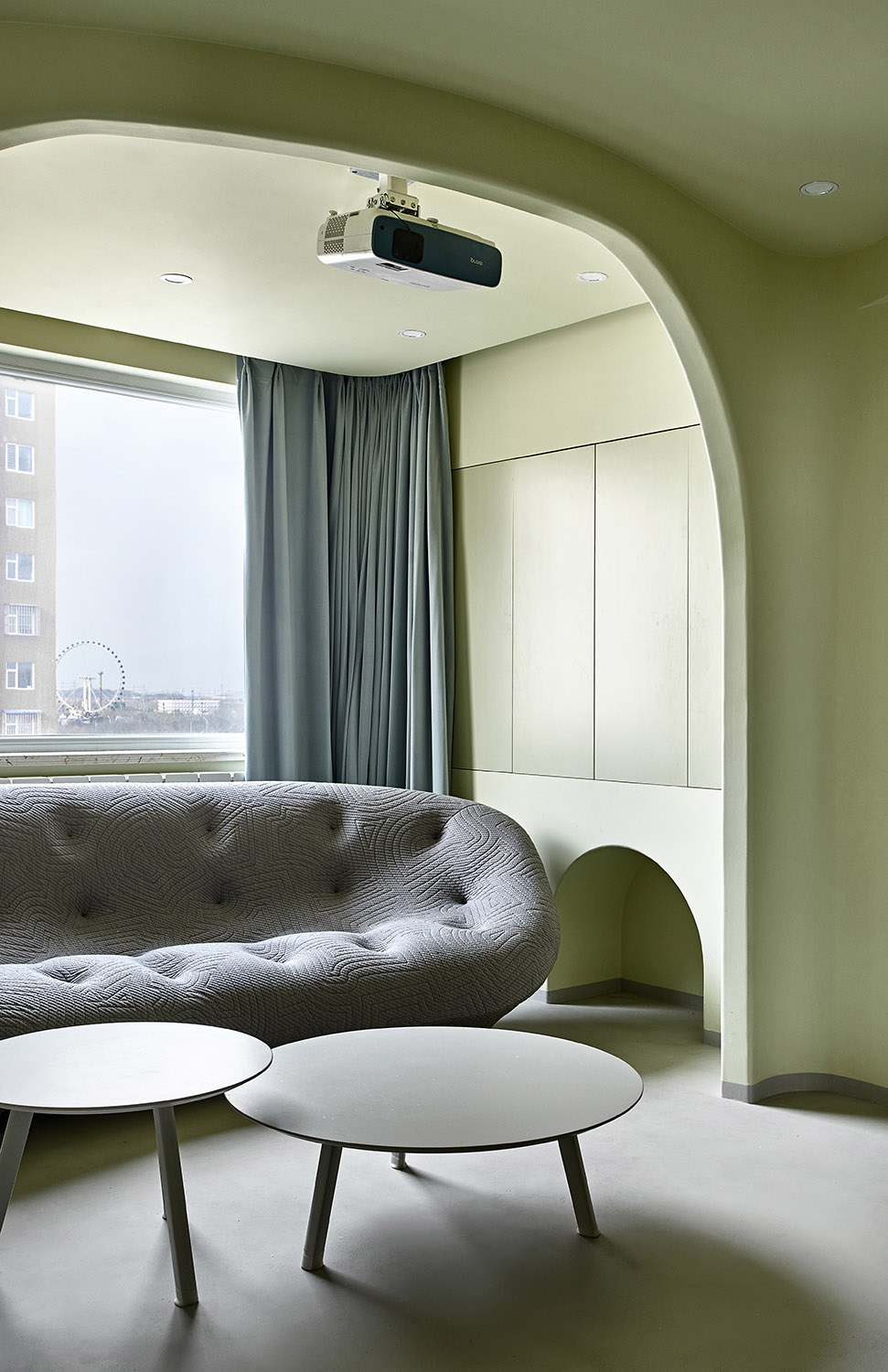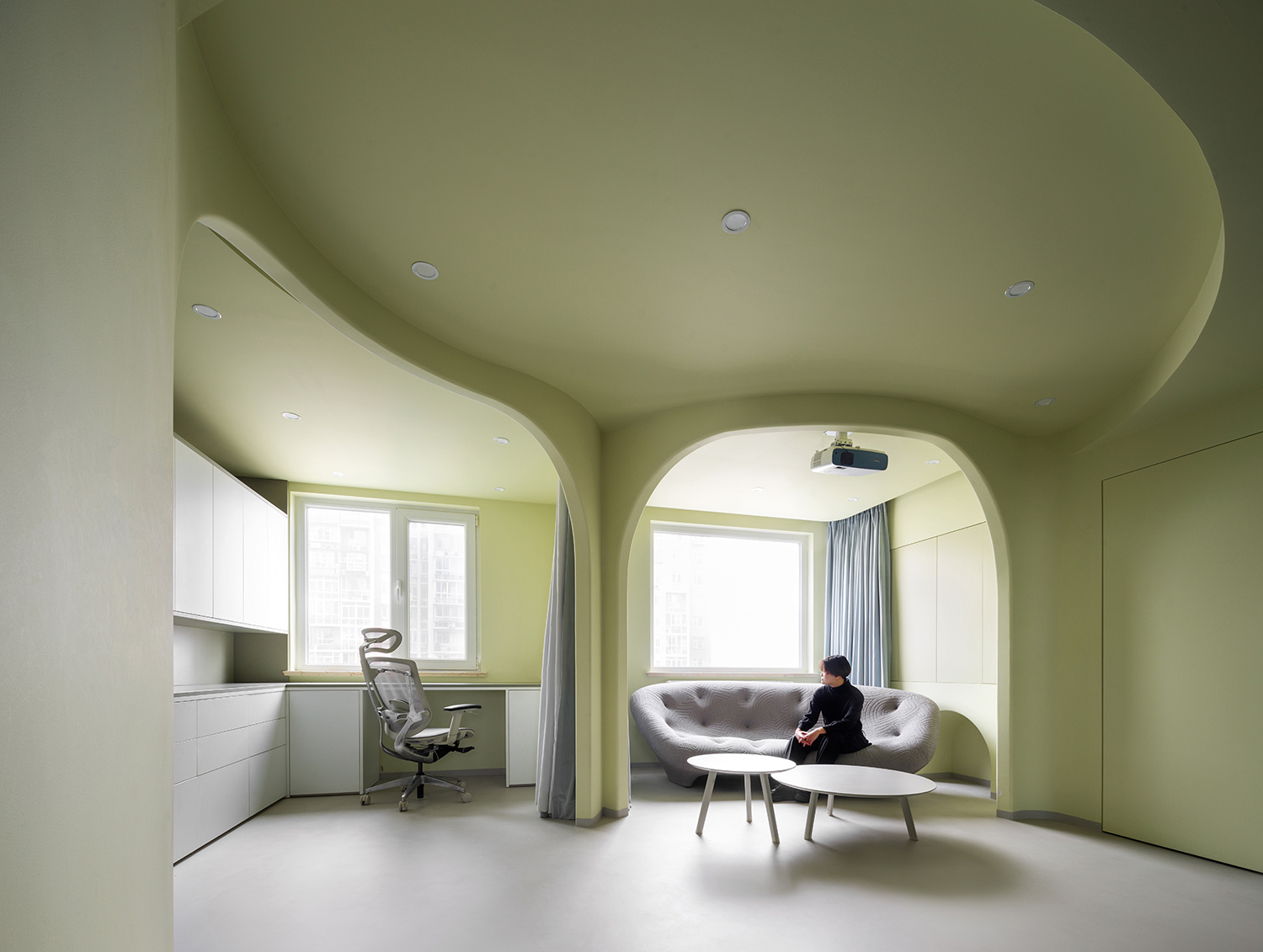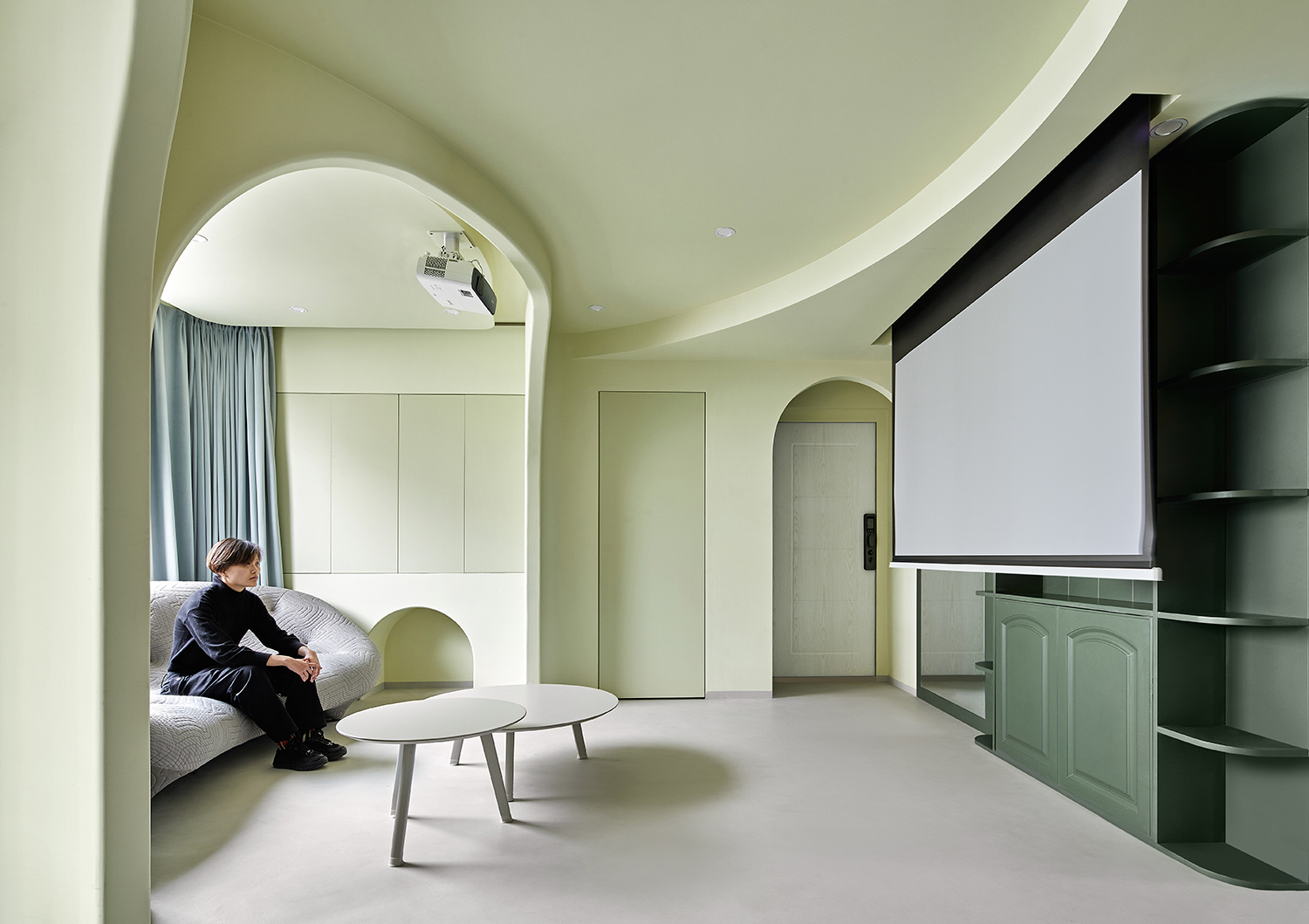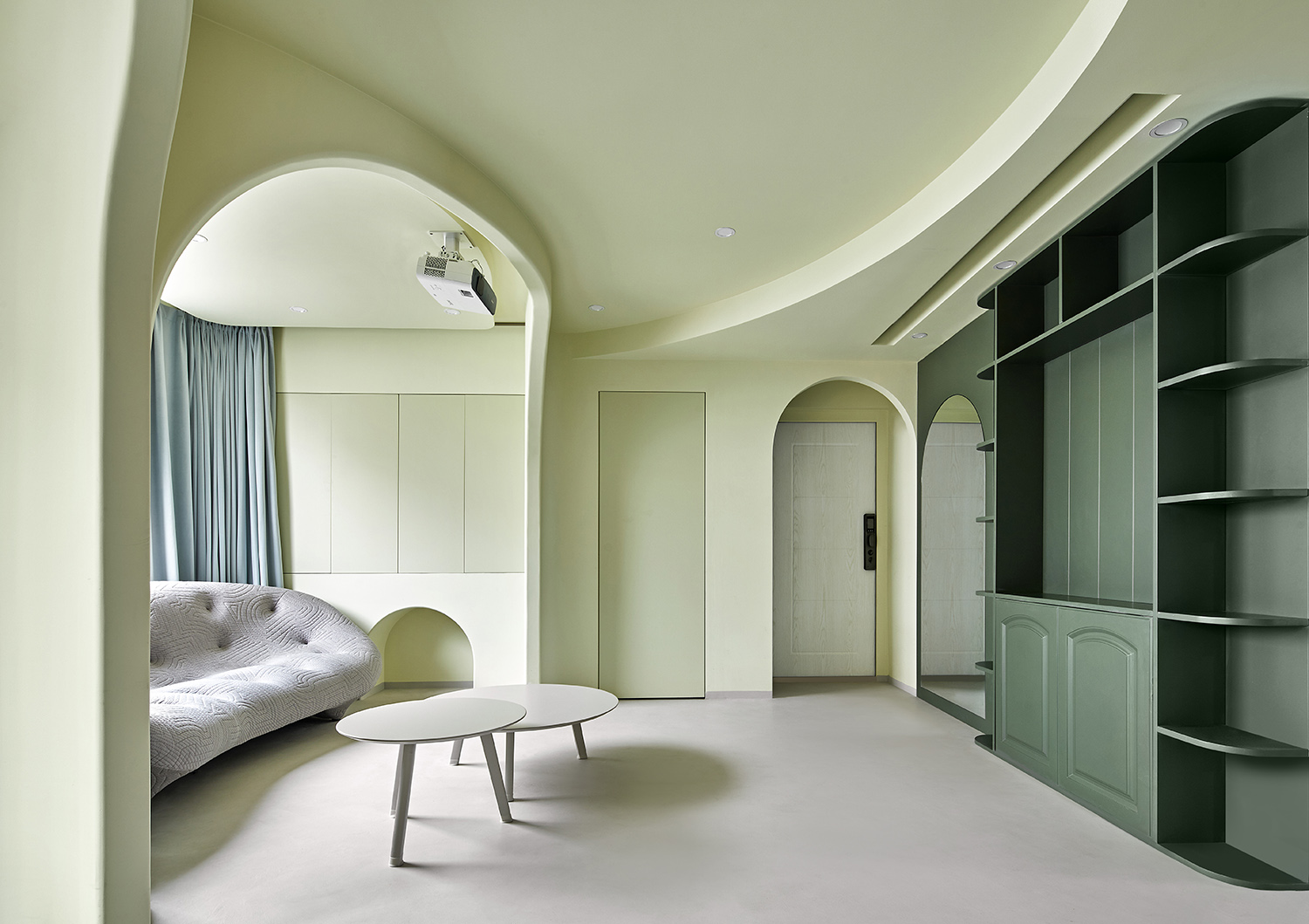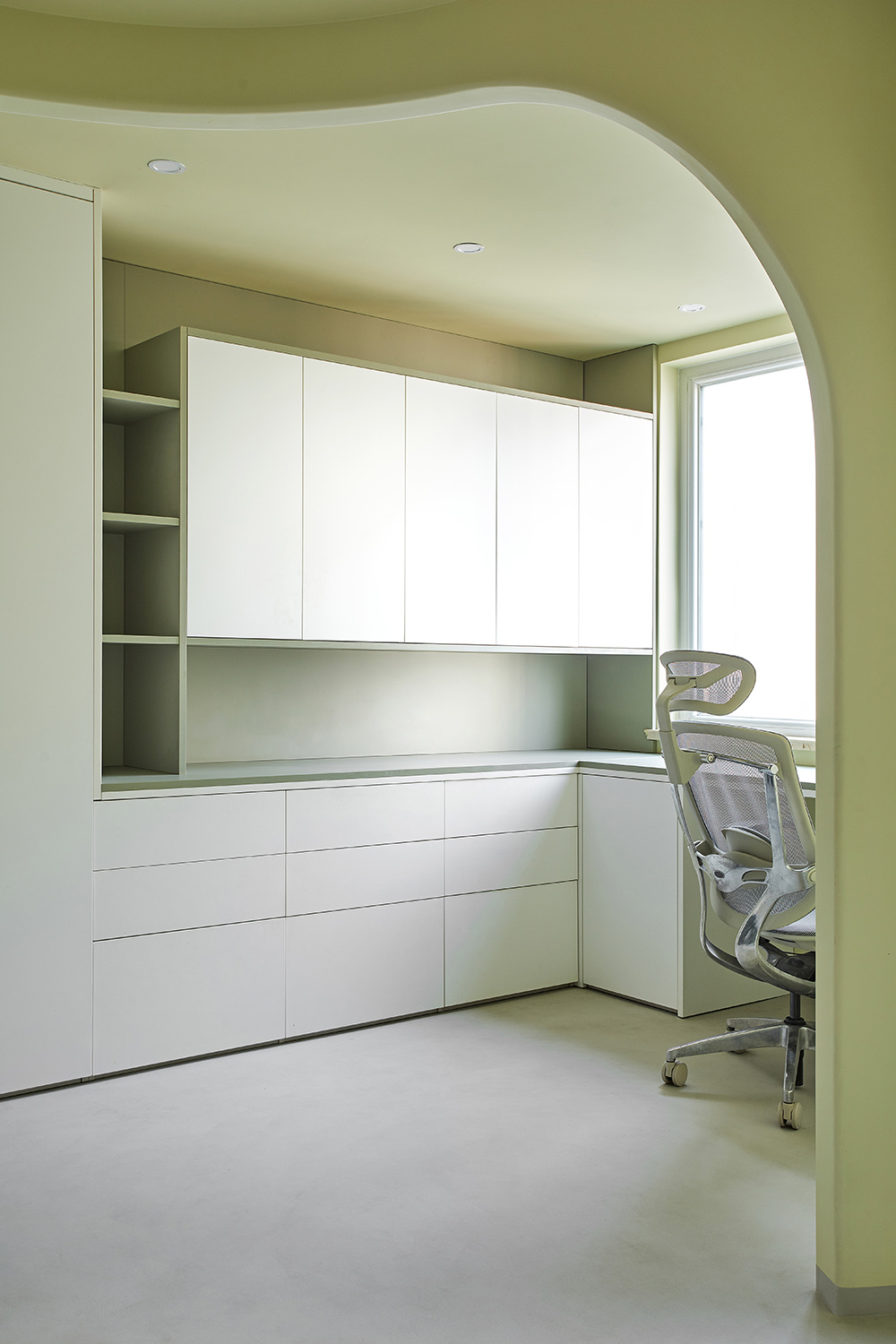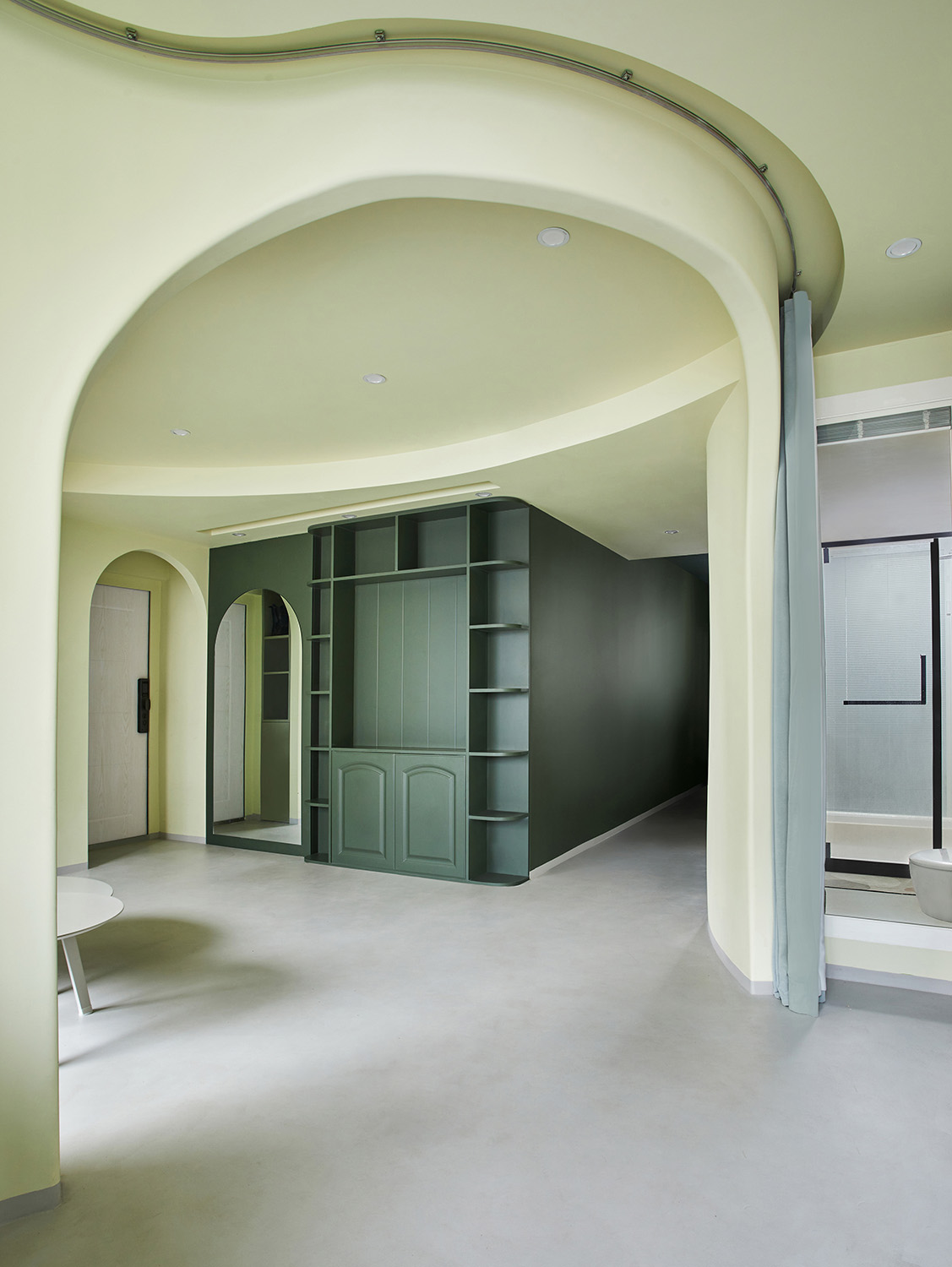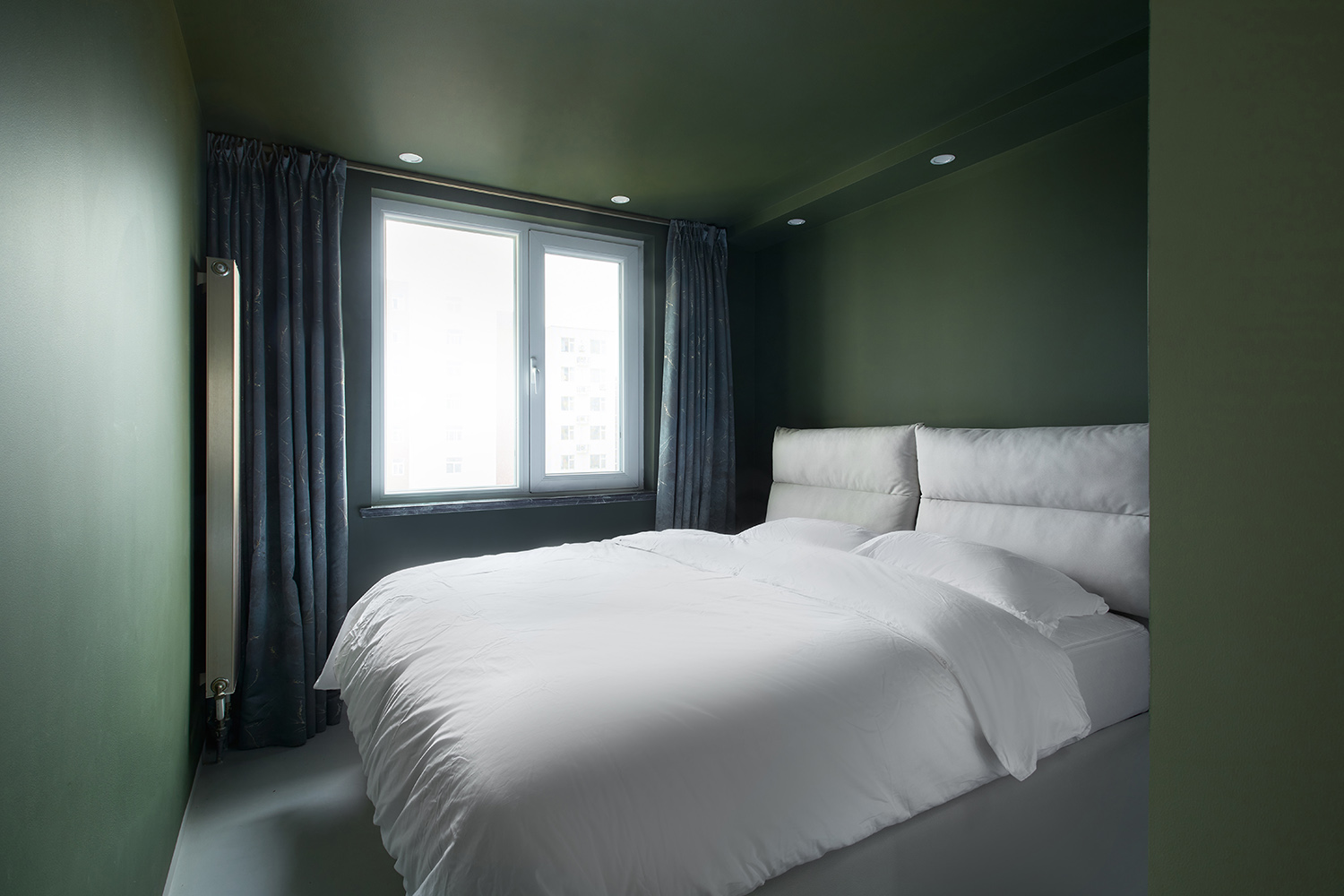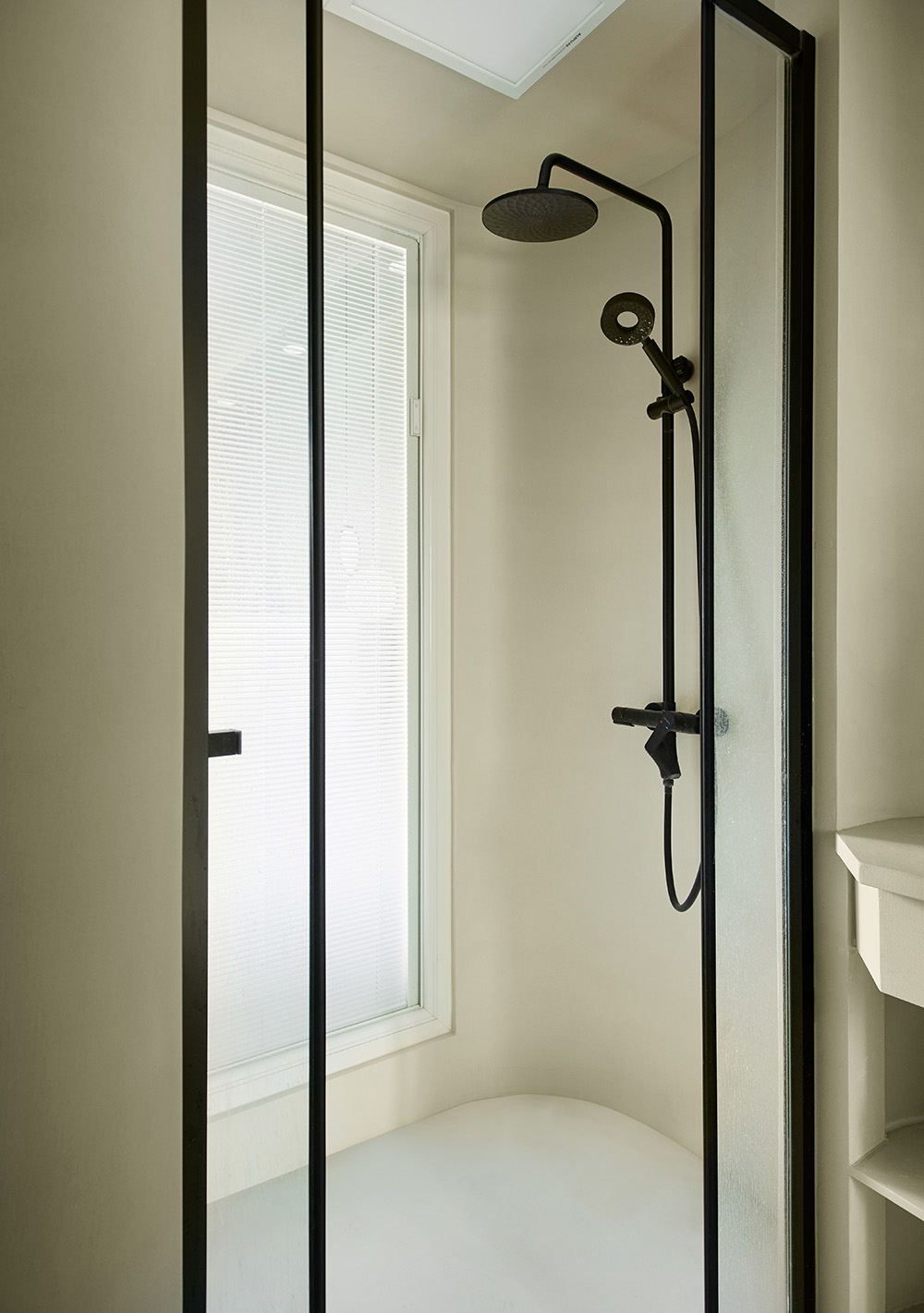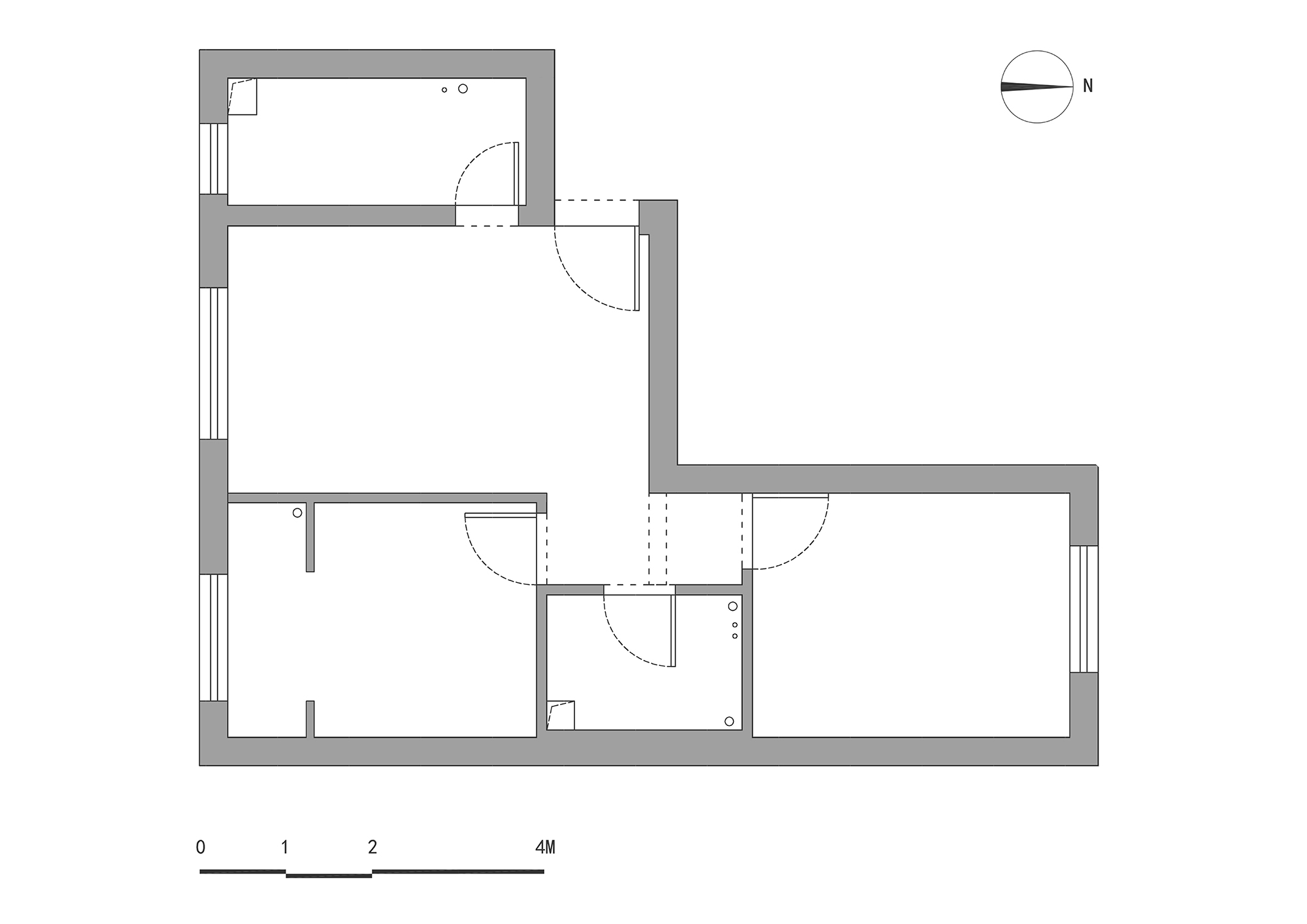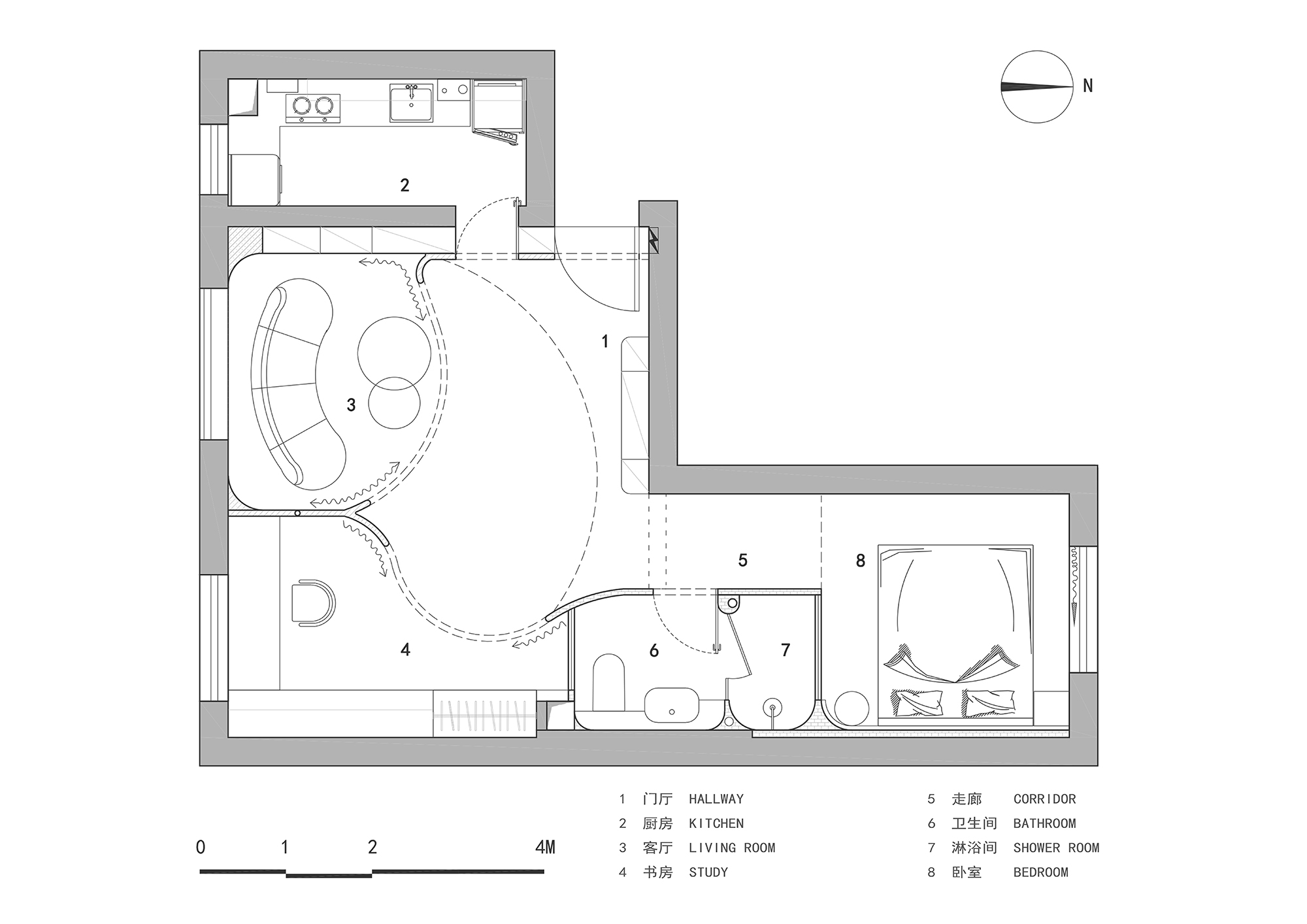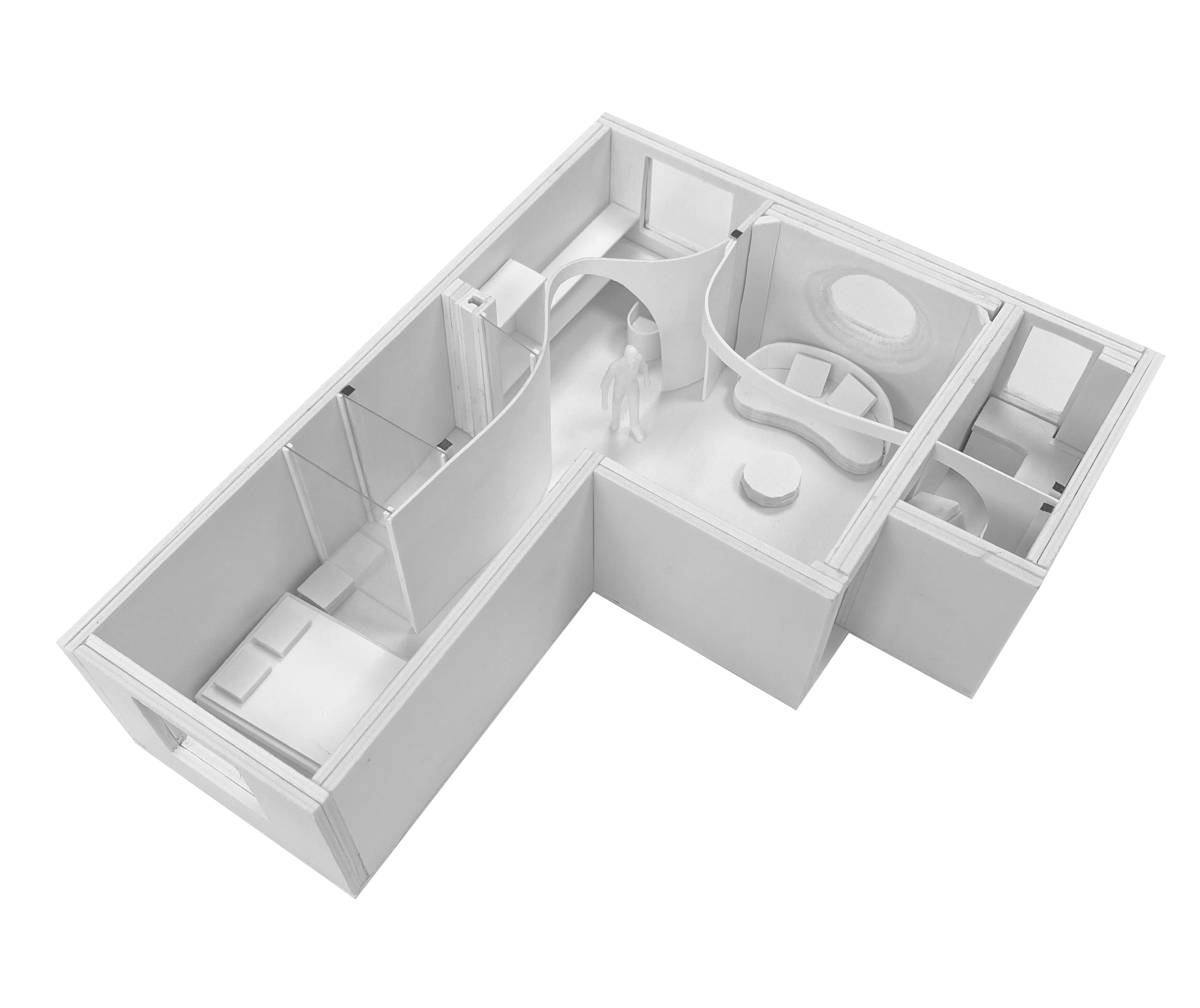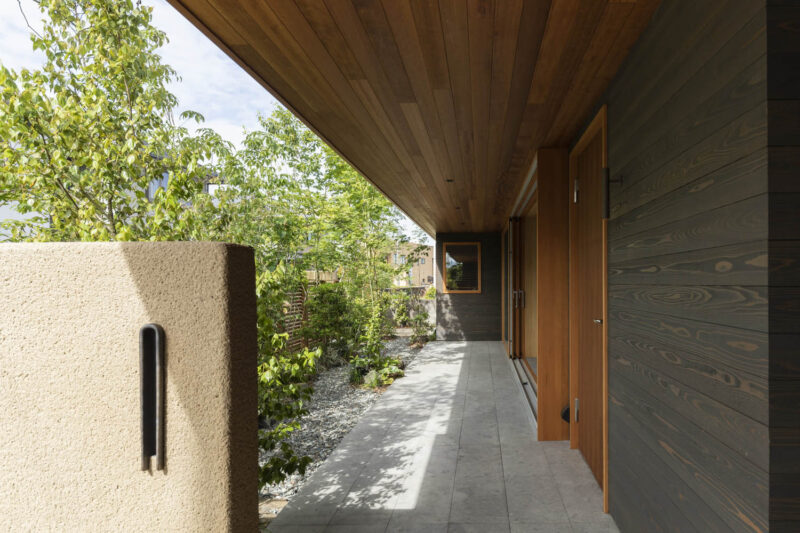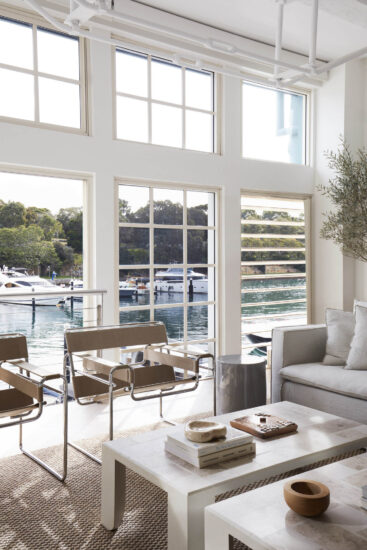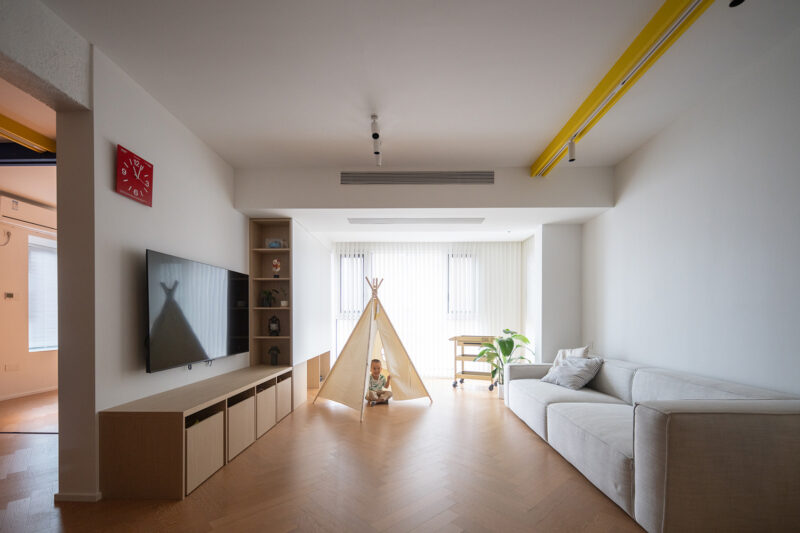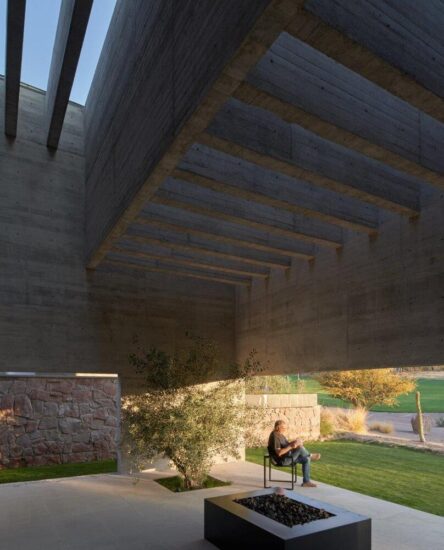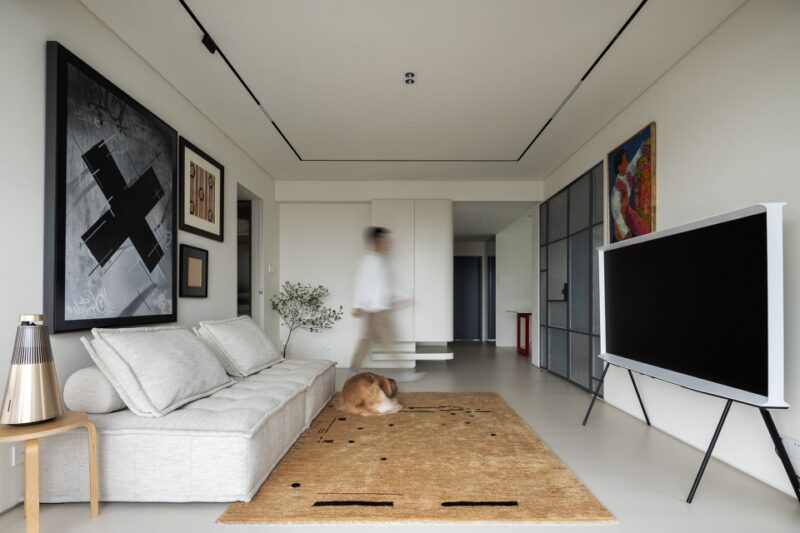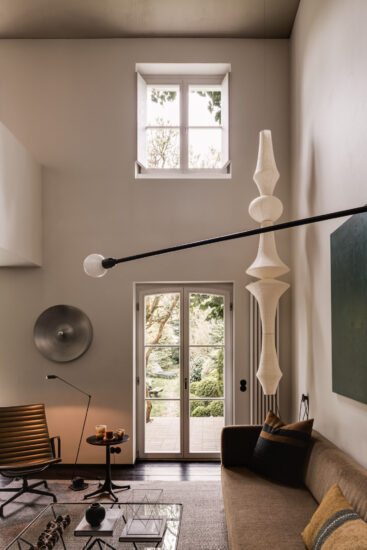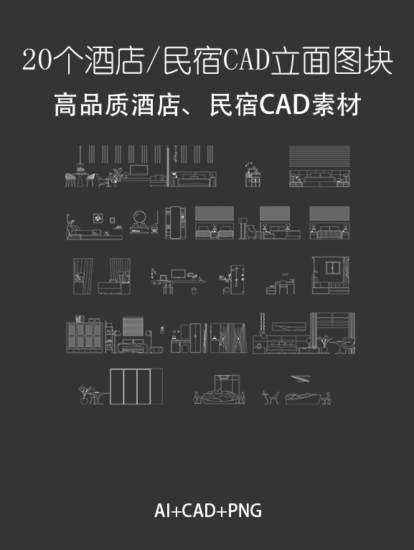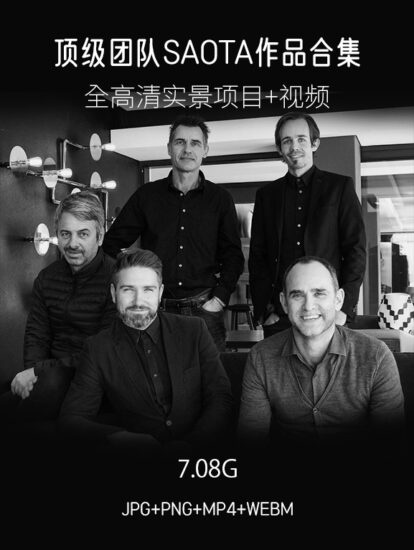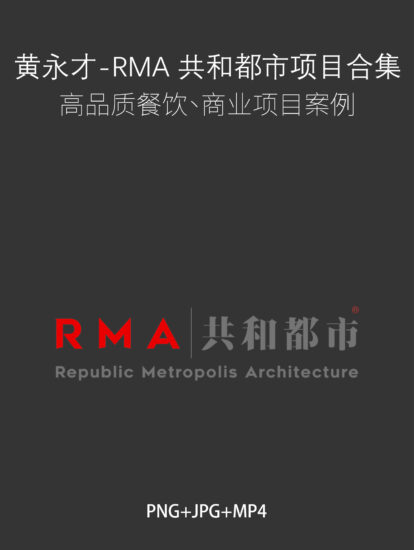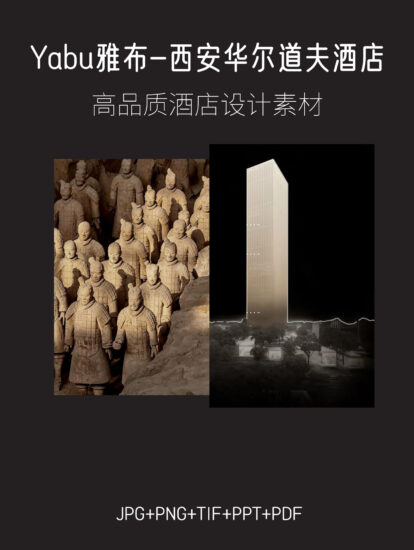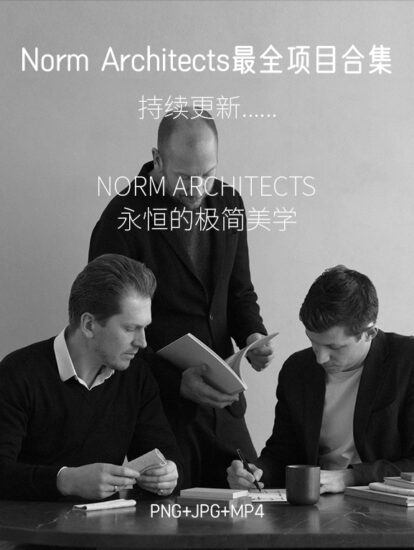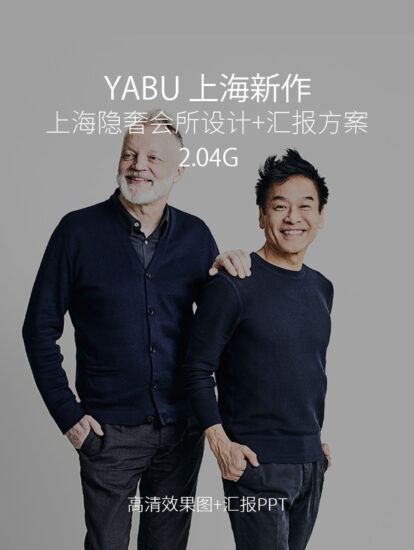概念闡述 Concept Statement
古羅馬劇場是根植於世俗文化的標誌性娛樂建築,多層拱劵形成的半圓場地是其獨特的建築結構。而由於古羅馬建築“大”的特征,拱柱結構逐漸從支撐的功能性轉向視覺裝飾性。我們利用拱柱形式構造空間形態為∇ 居者創造了一個供其“自導自演”的生活劇場。
The amphitheater is a symbolic entertainment building rooted in secular culture, with the semicircle field that was formed by multi-layer arch construction as its unique architectural structure. Due to the ancient Roman architecture’s feature of large scale, the arch structure gradually focuses on visual decoration more than its supporting function. We, through arch form, construct a space form to create a “self-directed and self-performed” life theater for the habitants.
∇ 概念圖
空間與居者之間的和諧關係建立在二者之間的交流對話上,居者個人的行為習慣和個性偏好編織成自我的生活語言,而空間構築也要借助各種形態語言。此案中設計師引用“劇場”的概念與形式建立起空間與居者的對話媒介,使二者在相互關係中演繹彼此的個性。
The harmonious relationship between the space and the habitants is established on the basis of the communication between the two. The habitants’ personal behavior habits and personality preference form their own living language, and the construction of space also needs the help of various form elements. In this case, the designer builds up the medium of dialogue between space and habitants by adopting the concept and form of “theater” so that the features of the two can be highlighted in their mutual relationship.
前期分析 Pre-phase Analysis
項目地點位於北京石景山遊樂園附近的住宅樓,業主為一位單身男士,並不打算將其作為常居的第一住所,而是用來“住著玩兒”,這一訴求與我們對空間奇趣性建構的興趣不謀而合,所以在項目開展之初,我們要求自己在滿足功能需求的基礎上,於48平米的小戶型尺度中將空間的通透與純粹盡可能放大到極致。
The project is near by the Beijing Shijingshan Amusement Park. The house owner is a single man who does not intend to use the house as his first habitual residence, but only as a “temporary resting place”. The owner’s such living demand exactly coincides with our interest in constructing a fancy and funny space. Therefore, at the beginning of the project, we require ourselves to maximize the transparency and purity of the space in a small house of 48 square meters on the basis of meeting the functional requirements.
∇ 原始場地
弧線“劇場” “Theater” with Arc Element
排除非必要牆體的影響,空間呈現為一個規整的方盒體,而在尺度有限的條件下,功能區的合理規劃似乎也沒有更多的變化可能,於是設計師將重點轉移到空間形態形式的構築上,運用弧線語言實現居所戲劇化的“變身”。
Excluded the influence of unnecessary walls, the space is presented as the shape of a regular box body. Finding there seems no more possibility of changes in the reasonable planning of functional areas under the condition of limited house area, the designer focuses on the construction of space form, and realizes the dramatic “transformation” of the house by adopting arc element.
∇ 分析圖
空間形態弧形化的過程為功能區間的排布連接方式提供了新的設計方向,大的拱形門洞既保留了空間的完整與通透,又成為了區分各功能區範圍的隱形邊界。
The process of cambering the space form provides a new design direction for the layout and connection of functional areas. The large arched door opening not only retains the integrity and transparency of the space, but also becomes an invisible boundary to distinguish the scope of each functional areas.
∇ 軸測圖
拱形門洞 Arched Door Opening
頂麵的流線型和垂直方向上的兩個連續的拱柱形態開口,使不同功能區得到區分,同時弱化了空間邊界的存在感,在這一開放性空間中,采光被最大限度引入室內,站在空間的任意一角,視線也能自由到達室外。
The streamline on the top face and the two continuous arched openings in the vertical direction distinguish the different functional areas and weaken the existence sense of the spatial boundary as well. In this open space, lighting is introduced to the indoor to the maximum extent, which makes it possible for habitants to see the scene of outdoor freely when standing at any corner of the space in the house.
彈性“帷幕” Elastic “Curtain”
用落地拉簾替代實牆作為功能區間的彈性隔斷,居者可以根據使用需求的變化開合落地簾,對空間場景進行自由切換。而這一過程也創造了“劇場感”的體驗,“帷幕”拉開,演出開始,“主人公”在空間中的豐富行徑即是表演。當居者需要空間處於封閉獨立狀態時,拉下“帷幕”,演出結束。
The floor-length curtain is used as the elastic partition of the functional area to replace the function of solid wall. The habitants can open and close the curtain according to their various demand, and freely switch the space scene. Such design also creates an opportunity of experiencing a “sense of theater”. When the curtain is opened, the performance begins, and the “house owners” various activities in the space are the performance. When the space needs to be enclosed and separated, the habitants can close the “curtain”, and their performance is over.
入口玄關 Hallway
入口處加構的拱形門洞與原入戶門之間形成一個包裹感的迷你玄關區,側麵方向設置玄關櫃,方便鞋衣等隨身物品的臨時收納。
The arched door opening that is added at the entrance, together with the original entrance door forms a mini hallway area with a sense of package. On the sideways of the entrance designs a porch ark which is convenient for habitants’ temporary storage of their shoes, clothes and personal belongings.
全身鏡、弧線天花以及垂直方麵上的拱柱形態一同被框入口門洞中,由近即遠,弧線形態錯落交疊,一覽空間的豐富層次。
The full-length mirror, arc-shaped ceiling and arch form in the vertical direction are framed into the door opening at the entrance. The arc shapes stagger and overlap from near to far, making it easy for the habitants to view the rich layer of the space.
開放起居空間 Open Living Space
沙發和圓形茶幾等家具單品的選用迎合了空間形態,窗外圓形摩天輪的入鏡也增添了畫麵趣味。而除生活必要設施的布置,設計師也將家居裝飾的比率降至最低,使空間形態以更加純粹的方式展現在眼前。
The selections of sofa, round tea table, and other furniture items fit the space form. The circular ferris wheel outside the window also adds fun to the house space. In addition to the layout of necessary facilities for life, the designer also minimizes the ratio of home decoration, so that the space form can be presented out in a more pure way.
投屏落下 The Projection Screen Fall down
使用投屏替代電視,蝸居在沙發中望向屏幕,頗有一種在劇場觀影的體驗。
Projection screen is used to replace TV, creating an experience of watching movies in a theater for the habitants when they dwell on the sofa and look at the screen.
書房 Study
工作台靠窗布置,男屋主平日有打電腦遊戲的習慣,遊戲之餘,抬頭便能眺向窗外緩解疲勞。白色儲物櫃與工作台連為一體,簡約明快。
Worktable is arranged beside the window. The male owner of the house has the habit of playing computer game at his ordinary times. After game, the male owner can alleviate his fatigue by looking up to overlook the scene outside the window. White locker and worktable are connected as a whole, creating a contracted and lively atmosphere.
走廊 Corridor
淺黃色和中綠色形成色彩對比而不顯得衝突。綠色從入口處延伸至北部臥室,暗示走廊盡頭空間功能屬性的變化。
Light yellow and medium green create a color contrast without any conflict. The green extends from the entrance to the bedroom in the northern part, suggesting a change in the functional properties of the space at the end of the corridor.
臥室 Bedroom
臥室大麵積的深綠色,暗示空間功能屬性的同時降低了整體的色彩明度,提升就寢的安全感與舒適感。
Dark green adopted in the large area of the bedroom not only suggests the functional properties of the space, but also reduces the overall color brightness, improving the sense of security and comfort at bedtime.
衛生間 Bathroom
衛生間處於臥室與起居室之間的位置,入口麵向走廊,用玻璃替代衛生間南北兩麵實牆,引入采光的同時創造視線的連通。
The bathroom is located between the bedroom and the living room, and its entrance faces the corridor. Glass is used to replace the solid walls on the north and south sides of the bathroom, which not only can introduce light, but also can create a visual connection.
∇ 原始平麵 Plan before renovation
∇ 改造後平麵 Plan after renovation
∇ 手工模型 Model
項目信息
項目名稱:劇場屋
項目地址:北京市昌平區體育場路
項目類型:住宅
建築麵積:60㎡
設計公司:戲構建築設計工作室 XIGO STUDIO
方案主創:劉陽、李柯錦
方案深化:王丹
主要材料:宅匠米耐岩、芬琳漆、愛格板、寫意空間
設計時間:2020年5月-2020年9月
施工完成:2021年12月
撰文排版:劉陽、於水驕
空間攝影:立明
Project Name: THEATRE HOUSE
Project Address: Tiyuchang Road, Changping District, Beijing
Project Type: Residential
Building Area: 60㎡
Design Company: XIGO STUDIO
Chief Designer: Liu Yang, Li Kejin
Scheme Deepening Design: Wang Dan
Main Materials: CIMENT ART, TIKKURILA-OY, EGGER, LIGNE ROSE
Design Period: May 2020 – September 2020
Completion of Construction: December 2021
Copywriter and Typesetting: Liu Yang, Yu Shuijiao
Space Photographer: Li Ming


